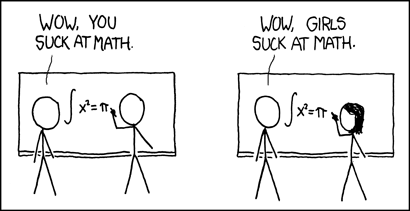The other day, my mother and I were discussing how to get ready for the coming Common Core State Standards (CCSS). She's a middle school math teacher in Oregon and part of her district's committee for transitioning from the Oregon State Standards (OSS) to the CCSS.
Getting ready for the CCSS is a daunting task. As compared to the OSS, the Common Core standards are written using different language, contain different amounts of detail and instruction, are organized differently, and necessitate a different approach to assessment. It's no wonder educators all over the state are feeling overwhelmed. We've gotten used to the OSS and now we have to start again, from the ground up, with these new standards.
Like it or not, the CCSS are coming and we need to be ready. That's where the committee that my mom is on comes in. She and her comrades are responsible for reconstructing their curriculum as necessary to accomodate these new standards. Which brings us back to the point of this post, which is to write about what my mom and I discussed.
As an engineer, my first inclination is to identify the goal, identify the context, plan a solution, execute that solution, and then check to make sure the solution actually accomplishes the goal (in that order). So that's what I did with my mom. The goal of our conversation was to figure out how her district could make sure their students were meeting proficiency for the new standards. Here's the plan we came up with:
1) Divide the standards up among the grade level teachers (e.g., there are 29 CCSS 6th grade standards for math and 5 6th grade math teachers at my mom's school, so each teacher gets 6 standards)
2) Each teacher fills out the table below for their standard (seen below with examples and italicized explanations)
| Standard Text | Knowledge | Reasoning | Demonstration | Product |
| 6.NS.2: Fluently divide multi-digit numbers using the standard algorithm (This is verbatim the text of the standard) | the algorithm for division (this is all the rote knowledge that students need to be proficient at the standard) | methodical step-by-step reasoning skills (these are all the reasoning skills that students need to be successful at this standard) |
perform the standard algorithm for division (this is a list of everything the students need to demonstrate in order to be successful at this standard)
|
N/A (This is a list of all the things that students need to produce or create in order to be successful at this standard)
|
6.RP.3: Use ratio and rate reasoning to solve real-world and mathematical problems, e.g., by reasoning about tables of equivalent ratios, tape diagrams, double number line diagrams, or equations.
a. Make tables of equivalent ratios relating quantities with whole-number measurements, find missing values in the tables, and plot the pairs of values on the coordinate plate. Use tables to compare ratios
b. Solve unit rate problems including those involving unit pricing and constant speed. For example, if it took 7 hours to mow 4 lawns, then at that rate, how many lawns could be mowe in 35 hours? At what rate were lawns being mowed?
c. Find a percent of a quantity as a rate per 100 (e.g., 30% of a quantity means 30/100 times the quantity); solve problems involving finding the whole, given a part and the percent.
d. Use ratio reasoning to convert measurement units; manipulate and transform units appropriately when multiplying or dividing quantities.
|
Vocabulary: rate, ratio
|
1) Compare rates and ratios
2) Reason connections between rates/ratios and real-world situations
|
1) Plot values on coordinate plane
2) Solve unit rate problems
3) Convert percentages to fractions & decimals
4)
|
Table of equivalent ratios
|
3) Each teacher devises several example assessments appropriate for the type of task (i.e., knowledge, reasoning, demonstration, product) required for each standard (devised via Marzano's thing)
4) All the teachers for the grade level get together and develop a full set of assessments for all the standards for that grade (e.g., the 6th grade teachers get together and develop a full list of assessments for the 6th grade standards)
5) Create a timeline dictated by the assessments (e.g., determine when each assessment needs to be given to the students so that every assessment created in step 3 is given within the full school year)
6) Teachers develop lesson plans as part of a professional learning community that will provide each student the opportunity to pass each assessment
When we were coming up with this plan we were thinking that each teacher could be responsible for creating a set of example assessments for each standard. Filling in the table should help guide exactly what kind of assessments would really show that students are proficient at each standard. Then, when all the teachers get together, they can share out what they have and work together to make a rigorous battery of assessments for each standard.
Yes, this would take a lot of work. But what's worse, spending the time now to set things up right in the first place or slapping something together now and spending the next ten years picking up the pieces?
Just a thought.


